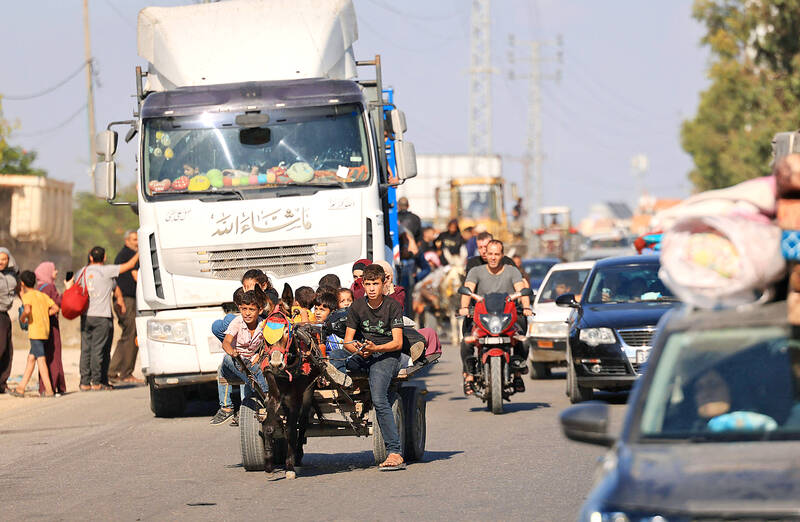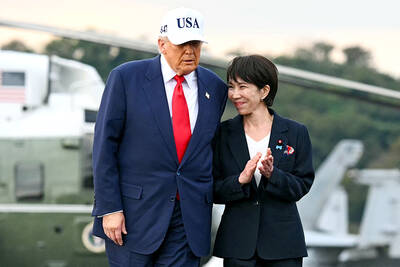Palestinians yesterday scrambled to flee northern Gaza after the Israeli military ordered nearly half the population to evacuate south and carried out limited ground forays ahead of an expected land offensive a week after Hamas’ bloody, wide-ranging attack into Israel.
Israel renewed calls on social media and in leaflets dropped from the air for about 1 million Gaza residents to move south, while Hamas urged people to stay in their homes.
The UN and aid groups have said that such a rapid exodus would cause untold human suffering, with hospital patients and others unable to relocate.

Photo: AFP
Families in cars, trucks and donkey carts packed with possessions crowded a main road heading away from Gaza City as Israeli airstrikes continued to hammer the 40km long territory, where supplies of food, fuel and drinking water were running low because of a complete Israeli siege.
Egyptian officials said the Rafah Border Crossing would open later yesterday for the first time in days to allow foreigners out.
Israel said that Palestinians could travel within Gaza without being harmed along two main routes from 10am to 4pm.
The Israeli military said “hundreds of thousands” of Palestinians had already heeded the warning and headed south, but some live up to 20km away, and roads demolished by airstrikes and a fuel shortage hindered their journeys.
Thousands of people crammed into a UN-run school-turned-shelter in Deir al-Balah, a farming town south of the evacuation zone. Many slept outside on the ground.
“I came here with my children... We don’t have a mattress, or clothes,” said 63-year-old Howeida al-Zaaneen from the town of Beit Hanoun. “I want to go back to my home, even if it is destroyed.”
The military said its troops conducted temporary raids into Gaza to battle militants and hunted for traces of about 150 people who were abducted during Hamas’ assault on southern Israel on Saturday last week.
Hamas said Israel’s airstrikes had killed 13 hostages, including foreigners, but did not provide their nationalities.
The military denied the claim.
The Palestinian Ministry of Health in Gaza yesterday said that more than 2,200 people have been killed in the territory, including 724 children and 458 women.
The Hamas assault killed more than 1,300 people on the Israeli side, most of them civilians, and about 1,500 Hamas militants were killed during the fighting, the Israeli government said.
Fearing a mass exodus of Palestinians, Egyptian authorities erected “temporary” blast walls on Egypt’s side of the heavily guarded Rafah crossing, which has been closed for days because of Israeli airstrikes, two Egyptian officials said, speaking on condition of anonymity because they were not authorized to brief the media.
Raids into Gaza on Friday were the first acknowledgment that Israeli troops had entered the territory since the military began its round-the-clock bombardment in retaliation for the Hamas massacre.
The military said the ground troops left after conducting the raids.
US Secretary of State Antony Blinken met with Saudi Arabian Minister of Foreign Affairs Faisal bin Farhan in Riyadh yesterday, and both called for Israel to protect civilians in Gaza.
“As Israel pursues its legitimate right to defend its people and to trying to ensure that this never happens again, it is vitally important that all of us look out for civilians, and we’re working together to do exactly that,” Blinken said.

CALL FOR SUPPORT: President William Lai called on lawmakers across party lines to ensure the livelihood of Taiwanese and that national security is protected President William Lai (賴清德) yesterday called for bipartisan support for Taiwan’s investment in self-defense capabilities at the christening and launch of two coast guard vessels at CSBC Corp, Taiwan’s (台灣國際造船) shipyard in Kaohsiung. The Taipei (台北) is the fourth and final ship of the Chiayi-class offshore patrol vessels, and the Siraya (西拉雅) is the Coast Guard Administration’s (CGA) first-ever ocean patrol vessel, the government said. The Taipei is the fourth and final ship of the Chiayi-class offshore patrol vessels with a displacement of about 4,000 tonnes, Lai said. This ship class was ordered as a result of former president Tsai Ing-wen’s (蔡英文) 2018

UKRAINE, NVIDIA: The US leader said the subject of Russia’s war had come up ‘very strongly,’ while Jenson Huang was hoping that the conversation was good Chinese President Xi Jinping (習近平) and US President Donald Trump had differing takes following their meeting in Busan, South Korea, yesterday. Xi said that the two sides should complete follow-up work as soon as possible to deliver tangible results that would provide “peace of mind” to China, the US and the rest of the world, while Trump hailed the “great success” of the talks. The two discussed trade, including a deal to reduce tariffs slapped on China for its role in the fentanyl trade, as well as cooperation in ending the war in Ukraine, among other issues, but they did not mention

Japanese Prime Minister Sanae Takaichi yesterday lavished US President Donald Trump with praise and vows of a “golden age” of ties on his visit to Tokyo, before inking a deal with Washington aimed at securing critical minerals. Takaichi — Japan’s first female prime minister — pulled out all the stops for Trump in her opening test on the international stage and even announced that she would nominate him for a Nobel Peace Prize, the White House said. Trump has become increasingly focused on the Nobel since his return to power in January and claims to have ended several conflicts around the world,

GLOBAL PROJECT: Underseas cables ‘are the nervous system of democratic connectivity,’ which is under stress, Member of the European Parliament Rihards Kols said The government yesterday launched an initiative to promote global cooperation on improved security of undersea cables, following reported disruptions of such cables near Taiwan and around the world. The Management Initiative on International Undersea Cables aims to “bring together stakeholders, align standards, promote best practices and turn shared concerns into beneficial cooperation,” Minister of Foreign Affairs Lin Chia-lung (林佳龍) said at a seminar in Taipei. The project would be known as “RISK,” an acronym for risk mitigation, information sharing, systemic reform and knowledge building, he said at the seminar, titled “Taiwan-Europe Subsea Cable Security Cooperation Forum.” Taiwan sits at a vital junction on